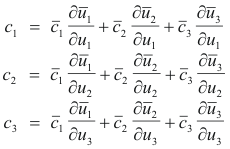Let us suppose that the transformation equations from a rectangular (x, y, z) system to the
![]() and
and
![]() systems are given by
systems are given by

and

and their inverses

and

There will exist a transformation directly from the
![]() system to the
system to the
![]() system defined by
system defined by

and conversely.
From 5) we obtain

By the definition of a gradient we have


and


Now the vector A is represented in the two coordinate systems as
![]()
The left members of 7) and 8) are thus equal. We now equate the coefficients of
![]() in 7)
and 8) to obtain
in 7)
and 8) to obtain

Substituting equations 6) with p = 1, 2, 3 in any of the equations 10) and equating coefficients of
![]() on each side, we obtain
on each side, we obtain

End of proof.